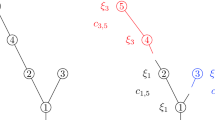Abstract
We analyze the Brownian Motion limit of a prototypical unit step reinforced random-walk on the half-line. A reinfoced random walk is one which changes the weight of any edge (or vertex) visited to increase the frequency of return visits. The generating function for the discrete case is first derived for the joint probability distribution of \(S_N\) (the location of the walker at the \(N^{th}\) step) and \(A_N\), the maximum location the walker achieved in \(N\) steps. Then the bulk of the analysis concerns the statistics of the limiting Brownian walker, and of its “environment”, both parametrized by the amplitude \(\delta \) of the reinforcement. The walker marginal distribution can be interpreted as that of free diffusion with a source serving as a diffusing soft confinement, details depending very much on the value of \(-1< \delta < \infty \).
Similar content being viewed by others
References
Davis, B.: Reinforced random walk. Probab. Theory Rel. Fields 84, 203–229 (1990)
Pemantle, R.: A survey of random processes with reinforcement. Probab. Surv 4, 1–79 (2007)
Keane, M.: Reinforced random walk. Bolyai Soc. Math. Studies 16, 151–158 (2007)
Kozma, G.: Reinforced random walk. arXiv:1208.0364v1, 1–16 (2012)
Sabot, C., Tarres, P.: Edge-reinforced random walk, arXiv:1111.3991.
Angel, D., Crawford, N., Kozma, G.: Localization for edge-reinforced random walks. Duke Math. J 163, 889 (2014)
Davis, B.: Brownian motion and random walk perturbed at extrema. Probab. Theory Relat. Fields 113, 501–518 (1999)
Nester, D. K.: A random walk with partial reflection at its extrema. Ph.D. Thesis, Purdue University (1993)
Sellke, T.: Recurrence of reinforced random walk on a ladder. Electron. J. Probab 11, 301–310 (2006)
Durrett, R., Kesten, H., Limic, V.: Once edge-reinforced random walk on a tree. Probab. Theory Relat. Fields 122, 567–592 (2002)
Tóth, B.: Generalized Ray-Knight theory and limit theorems for self-interacting random walks on \(Z^1\). Ann. Probab 24, 1324–1367 (1996)
Kac, M.: Random walk and the theory of Brownian motion, selected papers on noise and stochastic processes, Wax, N. (ed.) Dover Publications, New York (1954)
Percus, O.E.: Phase transition in one-dimensional random walk with partially reflecting boundaries. Adv. Appl. Probab. 7, 594–606 (1985)
Percus, O.E., Percus, J.K.: The Maximum of a symmetric next neighbor walk on the non-negative integers. J. Appl. Probab. 51, 162–173 (2014)
Author information
Authors and Affiliations
Corresponding author
Appendices
Appendix A. Marginal Distribution of the Maximum, Large \(b^2/t\)
It is sufficient to work directly with the Laplace Transform in time and then extract the time dependence. From (15) we have
Therefore
It is “only” the technical issue of carrying out the inverse Laplace Transform \(\mathcal {L}^{-1}_{t,s}\) that remains. Even for \(\delta =0\), this requires introduction of the Jacobi Theta function, not the best way to visualize the resulting situation. There are alternatives. One alternative is to make use of the rapid convergence of the series expansion
Using \(\mathcal {L}^{-1}_{t,s} \,e^{-c\sqrt{s}} = ce^{-c^2/4t}/2\sqrt{\pi }\,t^{3/2}\), we therefore have
Eq. (45) is an alternating series \(\sum ^\infty _0 (-1)^j\, a_j\), with
and so is certainly dominated by the first (Gaussian) term if
Appendix B. Marginal Distribution of the Maximum, Small \(b^2/t\)
The analysis simplifies materially if \(\delta \) is an integer, which we henceforth assume. Then, in (45), we make the replacement \(j\rightarrow -1-j-\delta \), so that
Since \(\left(\begin{array}{l} j+ \delta \\ j \end{array}\right)=0\) when \(-\delta <j<0\), the upper bound in (47) can be replaced by \(-1\). Doing so, and adding to (47), we get
We can then make use of the extended Poisson transformation, which takes the form (see [14]),
For this purpose, we first assume that \(\delta \) is an even integer, and let \(j\rightarrow j-\frac{\delta }{2}\) in (48):
But \((-1)^{\delta /2} \left( \begin{array}{l} j+ \delta /2 \\ j-\delta /2 \end{array} \right) = \frac{1}{\delta !} \prod ^{\delta /2}_{k=1} \left( \left(k-\frac{1}{2}\right)^2 - \left(j +\frac{1}{2}\right)^2\right), \quad \text {and so}\)
With minor changes of notation, this expression for \(Q_0\,(t,b)\) was obtained in Ref. [14], and (49) was used to transform it to
The first example of the use of (51) is for \(\delta =2\):
and \(Q_\delta \) for higher values of \(\delta \) is even more involved.
Rights and permissions
About this article
Cite this article
Percus, J.K., Percus, O.E. Reinforced Brownian Motion: A Prototype. J Stat Phys 156, 917–931 (2014). https://doi.org/10.1007/s10955-014-1036-5
Received:
Accepted:
Published:
Issue Date:
DOI: https://doi.org/10.1007/s10955-014-1036-5




